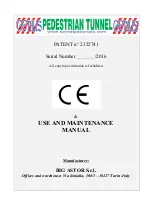
Instructions for use
PRIMEDIC
™
Defi-Monitor ECO 1 / DM 1 / DM 3
100
19499 / 05.03
How to avoid the "memory" effect?
The "memory" effect can be avoided by discharging the accumulator completely from time to time so
that a complete charging can be carried out. There are various possibilities for the practice:
1.
Do not immediately recharge the accumulator if it has only been discharged slightly. In most
cases sufficient energy is available for later applications. The
PRIMEDIC
™
Defi-Monitor
does
not always recharge the accumulator immediately. The accumulator is recharged only after
falling below a limit.
2.
Before charging the accumulator use the remaining capacity for e. g. several shocks with high
energy or for monitoring. This is not necessary every time before charging but only from time to
time (every week or month, depending on the use).
3.
Best accumulator care is obtained by means of the fully automatic discharging / charging unit
which carries out a defined discharging before every charging procedure. For safety reasons,
this charging process is not used with accumulators being charged directly in the defibrillator.
The worst case could be that the defibrillator is required just when the accumulator is
completely discharged. .
The fully automatic discharging / charging, i. e. the Accu-Care function is integrated in the
charging unit of the
PRIMEDIC
™
Defi-Monitor
. This option (retrofitting possible) allows to
charge a second
PRIMEDIC
™
Accu
and to avoid efficiently the "memory" effect by means of the
Accu-Care function.
Further effects of accumulators?
In daily practice, accumulators have two further features:
1. Self-discharge
2.
Aging after a longer period of use.
In practice
self-discharge
means that a full accumulator is subject to a slow but continuous loss of
charge. After approx. 4 weeks 90 % of the capacity are available. This effect, however, is only
important if several charged accumulators are kept "on stock".
The
PRIMEDIC
™
Defi-Monitor
is equipped with a circuit for conservation of the charge.
Even best maintenance of the accumulator does not avoid an aging after approx. 2-3 years (depending
on the use). After approx. 500-1000 charging cycles (depending on the type) it is impossible for the
accumulator to transfer the electric energy charged to the chemical storage. Thus the accumulator
becomes unusable and has to be replaced for a new one.
















































